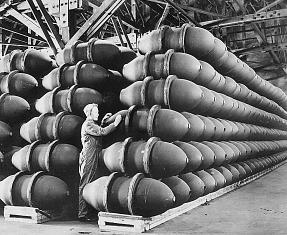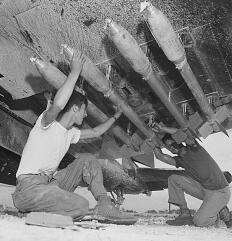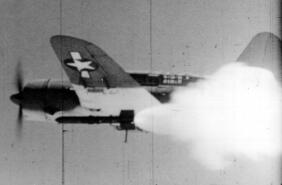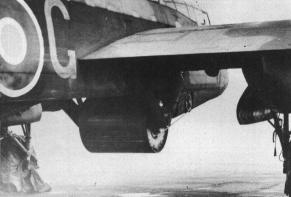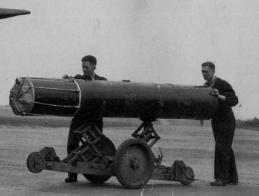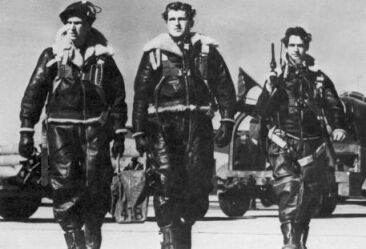Introduction to Aircraft Ordnance
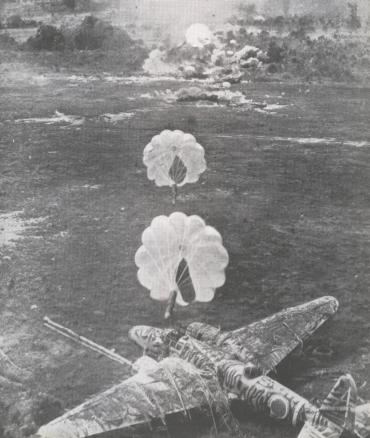 At the beginning of the war bombs were of considerably better design than the crude high-explosive packed artillery shells of the Great War. But there was still a great deal of room for improvement. The majority of bombs dropped during the war were high-explosive (general purpose) bombs of 250, 500 or 1,000 lbs. Incendiary devices, essentially thermite or magnesium burning at 1200 F or higher saw extensive use as well. These relatively small 2, 4, or 30 lb weapons were often dropped in huge numbers using cluster bombs. Cluster bombs contain many smaller bombs or submunitions which spill out when close to the ground to cover a large area. Anti-personnel attacks frequently relied on fragmentation bombs and fragmentation cluster bombs which send lethal metal fragments flying in all directions.
At the beginning of the war bombs were of considerably better design than the crude high-explosive packed artillery shells of the Great War. But there was still a great deal of room for improvement. The majority of bombs dropped during the war were high-explosive (general purpose) bombs of 250, 500 or 1,000 lbs. Incendiary devices, essentially thermite or magnesium burning at 1200 F or higher saw extensive use as well. These relatively small 2, 4, or 30 lb weapons were often dropped in huge numbers using cluster bombs. Cluster bombs contain many smaller bombs or submunitions which spill out when close to the ground to cover a large area. Anti-personnel attacks frequently relied on fragmentation bombs and fragmentation cluster bombs which send lethal metal fragments flying in all directions.
As the war went on some special purpose bombs were developed such as the Upkeep dam-busting bomb and the and Tallboy deep penetration bombs. In general bombs of heavier weight and blast came into greater use as the war continued.
Aerial Bombs
RAF Bombs
During the years following the Great War bombs were still thought of as little more than artillery shells dropped from airplanes. In 1937 a new series of bombs was adopted by the RAF which were aerodynamically shaped with tail fins, far more suited to being carried and dropped from aircraft. These came in a variety of ‘sizes’ from 40 lb bombs to 250 and 500 lb bombs. For the first two years of the war Bomber Command relied heavily on 250 lb and 500 lb GP high explosive bombs.
Bombs were classified by their CWR (Charge-to-Weight-Ratio) the percentage of explosive compared to the gross weight of the weapon. GP (General Purpose) bombs had a CWR of 30-35% meaning that most of the weight of these bombs consisted of metal casing not explosive. When it was realized that the weight of the bomb casing is a necessary evil, something to be reduced as much as possible this led to the development of new weapons such as the 4,000 HC (‘Block Buster’) which greatly increased the offensive power of RAF’s bombers.
MC (Medium Capacity) bombs had a CWR of 40-50% while HC (High Capacity) weapons had a CWR of 75-80%, the latter being essentially explosive packed metal drums. Extensive aerodynamic streamlining was dispensed with since these bombs were carried internally. As already mentioned the 4,000 lb ‘Block Buster’ or ‘Cookie’ was a very effective weapon in this class and after its introduction rapidly became a mainstay of Bomber Command.
GP – General Purpose CWR 30-35%
MC – Medium-Capacity CWR 40-50%
HC – High-Capacity CWR 75-80%
DP – Deep Penetration
AP – Armour Piercing
SAP – Semi-Armour Piercing
HE – High Explosive
I – Incendiary
SBC – Small Bomb Containers
TI – Target Indicator (airborne pyrotechnic stores)
PFF – Path Finder Force
RP – Rocket Projectile
A/S – Anti-Submarine
CWR – Charge-to-Weight Ratio
Nickels – Propaganda leafets dropped by air.
White Bomb – attack with propoganda leafets.
Gardening – Code-name for missions laying mines (known as cucumbers)
4 lb hexagonal stick magnesium incendiary
30 lb incendiary bomb
120 lb GP bomb – Standard inter-war bomb, used at start of World War II
40 lb GP/HE bomb
250 lb GP/HE bomb
500 lb GP/HE bomb
500 lb MC bomb
1,000 lb MC bomb
1,900 lb GP/HE bomb
2,000 lb MC bomb
4,000 lb MC bomb
4,000 lb HC/HE bomb ‘Cookie’
4,000 lb Pink Pansy
4,000 lb Red Spot Fire
8,000 lb HC bomb
US M41 20lb Fragmentation bomb
US M34 2000lb General Purpose bomb
Red Spot Fire – 4,000 lb incendiary bomb used as a target marker
Lancasters dropped no fewer than 217,640 1,000-pound bombs between 1942 and 1945.
First use Stats:
2,000 lb HE bomb – 7 May 1940 – by Coastal Command Beaufort
2,000 lb HE/SAP bomb – 1/2 July 1940 – Bomber Command dropped Hampden, on Kiel.
4,000 lb HE/HC (‘Cookie’) ‘block buster’ bomb – 1 April 1941 – two Wellingtons, against Emden.
8,000 lb HE/HC bomb – 1942 – Halifax first to use weapon operationally. Early September first 8,000 lb bombs became availible.
250 lb TI (Target Indicating) bomb – 16/17 January 1943 – by PFF against Berlin.
12,000 lb HE/HC bomb – 15/16 September 1943 – 617 Squadron, against Dortmund-Ems Canal.
12,000 lb HE/DP (‘Tallboy’) bomb – 8/9 June 1944 – 617 Squadron, against Saumur Tunnel.
22,000 lb HE/DP (‘Grand Slam’) bomb – 14 March 1945 – 617 Squadron, against Bielefeld Viaduct.
10-11 September 1942 – 4,000 lb ‘Pink Pansy’ incendiary bomb used as a target marker with a load of Benzol, rubber and phosphorus, dropped by Bomber Command on Dusseldorf.
A “cookie” or “blockbuster” was a 4,000 lb high capacity bomb. The RAF “heavies” dropped large numbers of these high-explosive bombs along with incendaries.
The RAF developed a 8,000 lb high-capacity bomb which was first used on Feb 10, 1942.
Tallboy and Earthquake Deep Penetration Bombs
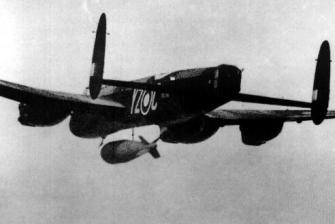 These massive bombs designed by Dr. Barnes Wallis came near the speed of sound during descent being streamlined and equipped with angled fins that produced spin. Penetrating the ground before exploding they worked by setting off shock waves that would bring down nearby structures. The 12,000 lb (5443 kg) Tallboy dropped from 20,000 ft (6096m) made a 80 ft (24m) deep crater 100 ft (30m) across and could go through 16 ft (4.88m) of concrete. On June 8-9, 1944 eight Lancaster bombers of No. 617 Squadron used the deep penetration Tallboy bomb in an attack against the Saumur Rail Tunnel. The new weapon proved its worth but at the cost of losing 5 of the 8 bomberson this mission. Eventually 854 Tallboy bombs were used, the most note-worthy mission resulting in the destruction of the battleship Tirpitz. The Grand Slam (Earthquake) bomb was of the same design as the Tallboy but larger and heavier weighing 22,000 lb (9972 kg.) The Grand Slam was first used on March 14, 1945 when a force of Lancaster bombers led by Royal Air Force Squadron Leader C.C. Calder attacked the Bielefeld railway viaduct destroying two spans. In another attack against submarine pens near Bremen two Grand Slams pentrated over 7m (23 ft) of reinforced concrete before exploding causing the collapse of the entire concrete ceiling. 41 Grand Slam Bombs were dropped by the end of the war mainly against bridges and viaducts.
These massive bombs designed by Dr. Barnes Wallis came near the speed of sound during descent being streamlined and equipped with angled fins that produced spin. Penetrating the ground before exploding they worked by setting off shock waves that would bring down nearby structures. The 12,000 lb (5443 kg) Tallboy dropped from 20,000 ft (6096m) made a 80 ft (24m) deep crater 100 ft (30m) across and could go through 16 ft (4.88m) of concrete. On June 8-9, 1944 eight Lancaster bombers of No. 617 Squadron used the deep penetration Tallboy bomb in an attack against the Saumur Rail Tunnel. The new weapon proved its worth but at the cost of losing 5 of the 8 bomberson this mission. Eventually 854 Tallboy bombs were used, the most note-worthy mission resulting in the destruction of the battleship Tirpitz. The Grand Slam (Earthquake) bomb was of the same design as the Tallboy but larger and heavier weighing 22,000 lb (9972 kg.) The Grand Slam was first used on March 14, 1945 when a force of Lancaster bombers led by Royal Air Force Squadron Leader C.C. Calder attacked the Bielefeld railway viaduct destroying two spans. In another attack against submarine pens near Bremen two Grand Slams pentrated over 7m (23 ft) of reinforced concrete before exploding causing the collapse of the entire concrete ceiling. 41 Grand Slam Bombs were dropped by the end of the war mainly against bridges and viaducts. 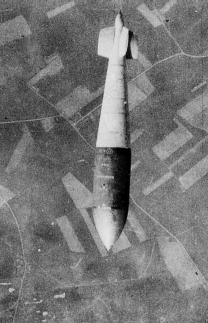
- Name: Tallboy
- Type: Deep Penetration Bomb
- Length: 21 ft (6.4 m)
- Diameter: 38 in (0.97 m)
- Weight: 12,000 lb (5,443 kg)
- Warhead: 5,200 lb (2,360 kg) Torpex explosive
- Number Used: 854
- Name: Grand Slam (Earthquake) Bomb
- Type: Deep Penetration Bomb
- Length: 26 ft 6 in (7.7 m)
- Diameter: 3 ft, 10 in (1.17 m)
- Tail Section length: 13 ft, 6 in (4.11 m)
- Weight: 22,000 lb (9972 kg)
- Warhead: 9,135 lb (4144 kg) Torpex explosive
- Number Used: 41
British 30-lb incendiary bomb
British 120-lb GP bomb
Standard inter-war bomb, used at the start of World War 2
British 250-lb Middle Capacity GP bomb
Standard inter-war bomb
British 500-lb GP bomb
Standard inter-war bomb
British 500-lb Medium-Case (MC) Mk III bomb
The MC bomb proved more effective than the ealier GP bombs, due to a higher filling:weight ratio. It was widely used by tactical aircraft, the 500-lb type also finding applications on heavy bomber aircraft.
British 4,000-lb ‘Cookie’
The Cookie is one of the demolition weapons employed by the RAF.
British 8,000-lb
Two 4,000-lb ‘Cookies’ bolted together
British 12000-lb High Capacity (HC) bomb
Three 4,000-lb ‘Cookies’ bolted together, not to be confused with the Tallboy deep penetration bomb.
British 12000-lb ‘Tallboy’ Deep Penetration Bomb
Could only be carried by the Avro Lancaster.
British 22000-lb ‘Grand Slam’ bomb
Could only be carried by the Avro Lancaster.
US M41 20-lb Fragmentation bomb
US M34 2000-lb General Purpose bomb
German Bombs
SC = SPRENGBOMBE CYLINDRICH (thin cased general purpose).
PC = PANZERBOMBE CYLINDRICH (armour piercing).
SD = SPRENGBOMBE DICKWANDIG (thick cased semi-armour piercing).
LC = LICHT CYLINDRISCHE (LC 50 parachute flare).
SC = SPRENGBOMBE CYLINDRICH – designed for maximum blast effect having a high charge-to-weight ratio of 55 per cent explosive SC bombs were used primarily for general demolition. Approximately 8 out of 10 of German high explosive bombs dropped on the U.K. were of the SC type. Sizes included 50 kg, 250 kg, 500 kg, 1000 kg “Hermann”, and the 1800 kg “Satan”. There was even a 2500 kg type although rarely used.
PC = PANZERBOMBE CYLINDRICH – Having a charge-to-weight ratio of 20% explosive, because of their penetration qualities they were used primarily against ships and fortifications. The 1400 kg “Fritz” is a good example of this type.
SD = SPRENGBOMBE DICKWANDIG – Medium cased steel weapons and, being either anti-personnel or semi-armour piercing, had a charge-to-weight ratio of 35 per cent explosive; 50, 250, 500 and 1700 kg versions.
LC = LICHT CYLINDRISCHE – About the same size as a conventional SC 50 bomb, hence its designation “50”. Used for target illumination and marking at night.
Land Mines.
The 1000 kg Luft Mine B was normally employed, and as such was designated Bomben B when used against land targets. During 1941 a new weapon, the BM 1000 “Monika”, made its appearance. This consisted of the sea mine LMB, but fitted with a bomb tail unit, designed to be dropped like a conventional bomb without a parachute.
U.S. Bomb Types:
The most devastating conventional bomb used by the Americans was the M-69 incendiary cluster. The first B-29 raids against the Japanese mainland were performed in the fall of 1944, using high-altitude daylight precision bombing with high-explosive bombs. For several reasons, this strategy proved ineffective, and by the spring of 1945 operations switched to low-level incendiary bombing at night.
The M-69 firebomb had been developed earlier in the war and proved ideal for the task of burning Japanese cities to the ground. The M-69 was a simple weapon, shaped like a long tin can and weighing just 2.3 kg (6.2lb). Since dropping quantities of individual bombs from high altitude would be wildly inaccurate – it was designed to be incorporated into an “aimable cluster”, a type of cluster bomb that contained 38 of the M-69 firebombs.
Aimable clusters would be released over the target and break apart at about 900m (2,000 ft) altitude, scattering their M-69s. Each M-69 would then eject a long strip of cloth to orient itself and crash nose-first into the buildings below. On impact the payload of napalm would ignite and shoot out of the tail of the bomb in a burning jet. Under ideal conditions, this jet could extend 45m (100 ft).
| Name | Type | Bomb Weight | HE Weight |
| AN-M30 | GP | 100 lb | 54 lb |
| AN-M57 | GP | 250 lb | 123 lb |
| AN-M64 | GP | 500 lb | 262 lb |
| AN-M65 | GP | 1,000 lb | 530 lb |
| AN-M66 | GP | 2,000 lb | 1,051 lb |
| AN-M56 | Light Case | 4,000 lb | 3,245 lb |
| AN-Mk1 | Armor-Piercing | 1,600 lb | 215 lb |
Incendiary Devices
| Name | Type | Weight | Notes |
| M47A1 | Wh. Phosphorous | 100 lb | Used Mainly in Europe During Last 6 months of War |
| M47A2 | Jellied Oil | 100 lb | Most Widely Used Incendiary by U.S. |
| M50 | Magnesium | 4 lb | Used Mainly in Europe |
| M52 | Magnesium | 2 lb | Used Mainly in Europe |
| M69 | Jellied Oil | 6 lb | – |
| M17 | Magnesium | 500 lb Cluster of 110 M50 | Most widely used Incendiary by 8th and 15th Air Forces |
| M19 | Jellied Oil | 220 lb Cluster of 36 M69 | Dropped in Huge Numbers During Fire Raids On Japan |
SBC – Small Bomb Containers
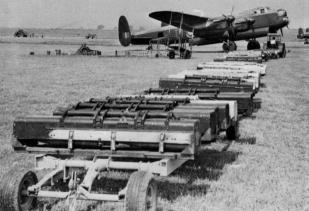
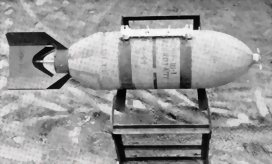
Each container held 236 x 4-lb or 24 x 30-lb incendiaries.
A Lancaster bomber could carry a maximum of 14 SBCs. This means that every Lancaster over a target could dispense up to 3,304 x 4-lb (13,216 lbs) or 336 x 30-lb (10,080 lbs) incendiary bombs. Another load-out for the Lancaster that is more representative is 1 x 4,000-lb HE bomb plus 12 SBCs.
Napalm
Napalm essentially “jellied” gasoline saw its first combat use during the invasion of Tinian in June 1944. Dropped by fighter-bombers and bombers it was used in subsequent assaults in the Pacific. For example, during 16 days of ‘softening up’ attacks proceeding the invasion of Iwo Jima B-24s dropped 1,111 drums of Napalm on the island.
Rocket Projectiles
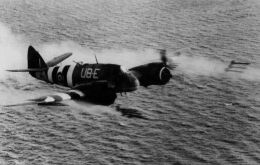 Air-to-ground rockets were in service before the war in several nations such as the Soviet Union but their use was limited. The Il-2 Stormovik and other Russian planes made devastating attacks against German armor and supply columns. In the west, fighter-bombers such as the American P-47 and the British Typhoon fired thousands of rockets at armor and troop concentrations. In the Pacific rockets were invaluable in the brutal island-hopping campaign where heavily defended positions had to be taken. Navy and Marine Corsairs smothered pill boxes and bunkers with rockets and napalm.
Air-to-ground rockets were in service before the war in several nations such as the Soviet Union but their use was limited. The Il-2 Stormovik and other Russian planes made devastating attacks against German armor and supply columns. In the west, fighter-bombers such as the American P-47 and the British Typhoon fired thousands of rockets at armor and troop concentrations. In the Pacific rockets were invaluable in the brutal island-hopping campaign where heavily defended positions had to be taken. Navy and Marine Corsairs smothered pill boxes and bunkers with rockets and napalm. 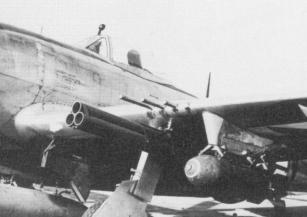
Another application for rockets was in the anti-ship / anti-submarine effort. British Beaufighters, Mosquitos and Typhoon became the scourge of enemy vessels even when protected by friendly fighters. Although air-to-ground rockets were used in the air-to-air role on occasion it wasn’t until the last months of the war in Europe that a true air-to-air rocket came into service, the German R4M. They were extremely effective but appeared too late to alter the course of the war. This type of weapon – the folding-fin rocket became standard armament for aircraft following the war till the advent of air-to-air missiles.
M-8 4.5 inch (11.4 cm) triple-tube “Bazooka” launcher
HVAR 5 inch (12.7 cm) rockets
Tiny Tim 11.75″ (30 cm)
RP Rocket Projectile
RS-82
RS-132
| Rocket | Diameter | Length | Weight | Warhead | Speed | Platform |
| M-8 | 4.5″ (11.4 cm) | 16″ (40 cm) | 860 ft/s (262m/s) | P-38, P-47, P-51 | ||
| HVAR | 5″ (12.7 cm) | 72″ (1.83m) | 140 lb (63.5 kg) | 55 lb (25 kg) | 1375 ft/s (419m/s) | P-38, P-47, P-51, Corsair, Hellcat |
| Tiny Tim | 11.75″ (30 cm) | 123″ (3.12m) | 1284 lb (582 kg) | 590 lb (270 kg) | 810 ft/s (247m/s) | B-25 A-20 |
| RP | 3″ (7.62 cm) | 55¼” | 47 lb (21.3 kg) | 25 lb (11.3kg) | 1575 ft/sec (480m/s) | Typhoon Tempest Mosquito Beaufighter |
| RS-82 | 3.2″ (8.2 cm) | 22″ (56.0 cm) | 1.28 lb (0.6 kg) | IL-2 | ||
| RS-132 | 5.2″ (13.2 cm) | 34″ (86.4 cm) | 5 lb (2.25 kg) | IL-2 |
RP aicraft ground attack rocket
Rocket Motor Tube
3¼” diameter 55¼” long
Total weight of 21.3kg (47 lb) w/ 25 lb AP head
11 lb cruciform stick of cordite – the main propellant charge.
Maximum Velocity of 480 m/sec (1,575 ft/sec)
- 60 lb Shell, HE/SAP
- 60 lb Shell, HE/GP, Hollow Charge
- 18 lb Shell, HE
- 25 lb Shot, AP
- 25 lb Head, Solid, A/S (Anti-Submarine)
- 60 lb Shell, Practice, concrete head (Training only)
- 12 lb Head, Practice, (Training only)
Unorthodox Weapons
Upkeep The Dam-Busting Bomb
Upkeep bomb
large cylindrical shaped weapon
weight: 9,250 lb (4200 kg)
explosive: 5,720 lb (2600 kg) torpex
hydrostatic fuze set to detonate at a depth of 30 ft (9m)
In December of 1942 a Wellington bomber was acquired to conduct full scale tests. After several abortive attempts Barnes Wallis got the spherical bomb to bounce 16 times across a stretch of water.
Modified Lancasters
23 ED serial block Lancaster bombers were extensively modified to accommodate the Upkeep weapon. The bomb bay doors were removed and special pylons fitted, together with an electric motor to set the mine spinning backward at 500 rpm before bomb release. This backspin was crucial as it allowed the bomb to skip across the water, past several torpedo nets, and strike the dam wall. The mid-upper gun turret was removed and its gunner moved to the nose turret where ‘stirrups’ were added to prevent him from inadvertantly treading on the bomb aimer’s head. Fighter type VHF radios were added to all of the aircraft, close control of the operation being vital to its success. Since the entire mission had to be flown at low altitude specailly prepared ‘roller maps’ were provided to the bomb aimers to assist in navigation.
The problem of flying each plane level at just 60 ft was solved by the ingenious use of a pair of Aldis lamps, one mounted in the nose camera port, the other behind the bomb bay. The lamps were angled so that the two spots of light touched at an altitude of 60ft and offset to starboard where they were easily seen by the navigator who monitored height during the bombing run. Standard bombsights could not be used due to the unique nature of the attack so a sight was improvised consisting of a plywood triangle, a simple eyepiece and a couple of nails. Finally each Lancaster was provided with 3,000 rounds of ammunition per gun, all tracer, to keep the German gunners heads down.
Johnny Walker Diving Mines
This British weapon 72 inches in length and weighing in the 500 lb class had a most unusual mechanism of action. With a main charge of approximately 100 lb Torpex/aluminum in a shaped charge and a hydrogen gas generation system the idea was to form a large bubble of hydrogen gas that would lift a warship out of the water and ‘break its back’.
Seven Lancaster bombers each carrying a dozen Johnny Walker bombs attacked the battleship Tirpitz in September 1944. No damage was inflicted and the Johnny Walkers were never used again. As ingenious as the concept was in actual use the weapon failed to produce the desired effect.
Interestingly enough 43 years after the attack the Norwegians found one of the Johnny Walker devices still intact near Kara Fjord.
Highball ‘Bouncing Bomb’
This spherical bomb was designed by the brilliant Dr. Barnes Wallis to be utilized against ships. Weighing 1,280 lb (580kg) and packed with 600 lb (272 kg) of explosive two Highballs could be carried by a Mosquito fighter-bomber. Prior to release the bomb was imparted with a backward spin of 700-900 revolutions per minute. Dropped at high speed 360 mph (580km/h) and low altitude 60 ft (18.2m) the Highball would skip across the water toward the target.
Although intended to be used against the battleship Tirpitz this did not come to pass mainly because the ship stayed in ports beyond the range of Mosquitos based in Britain. Focus shifted to possible use in the Far East and a number of Mosquitos were modified for use on escort/jeep carriers. Despite considerable training the weapon was not used in combat.
‘Disney’ Rocket-Assisted Bomb
Designed by Captain Terrell RN of the UK, this 4,500 lb (2040 kg) hard-case streamlined bomb was intended to be used against U-boat pens and other super-hardened targets.
Dropped from 20,000 ft (6096 m) the bomb had a barometric fuze which activated at 5,000 ft (1525 m.) At this point a rocket in the tail of the bomb fired bringing the impact velocity up to 2,400 ft/sec (730 m/sec.)
Carried on B-17 bombers in pairs under-wing this weapon was first used on Febuary 10, 1945. Nine B-17s of the 92nd BG dropped eighteen Disney bombs on U-boat pens at Ijmuden in Holland, scoring one direct hit. The weapon saw further use but suitable targets were often either too far away (such as in Norway) or already over-run by Allied troops. Still by the end of the war a total of 158 Disney Bombs had been used in combat.
Project Aphrodite
This involved taking war weary B-17F bombers and packing them with 20,000 lb (9070 kg) of Torpex or 10 tons of RDX explosive. A volunteer two man crew conducted the take-off and flew the plane to cruising altitude. After arming the plane, hopefully without setting off an explosion, the crew would bail out while a chase plane, another bomber, usually a B-34 (an-RAF Ventura,) would direct the bomb laden plane into the target via a radio control link. The idea worked better in practice than in actual combat as several of the planes exploded prematurely and the basic stability of the B-17 in flight frustrated efforts to nose the bomber down into the target. Seven of these missions were flown in the month of August under the code name Aphrodite. The first Aphrodite mission was flown against V-2 rocket sites in the Pas de Calais area of France on August 4, 1944.
Japanese Balloon Bombs
During 1944 and into 1945 the Japanese carried out a most unusual bombing campaign. Large paper balloons fitted with an ingenious mechanism for maintaining altitude during the 6,200 mi (9,970 km) 3-5 day trip across the Pacific to America were launched in great numbers. Each balloon carried a small incendiary device as it travelled at 25-170 mph (35-270 km/h) between 30,000-50,000 ft (9,144-15,240 m) altitude. The thinking was that the large forested areas of the United States could be set ablaze by the incendiary bombs dropped by these balloons. In November of 1944 the remains of some of these balloon bombs were discovered and reported. By March the following year reports indicated that roughly 100 of these balloon bombs were crossing the Pacific per month. On March 5, 1945 Mrs. Elsie Mitchell and five children were killed when they came upon one of the incendiary devices while out fishing at a lake. These were the only casualties of enemy action against the mainland of the United States during World War II. Altogether some 9,300 balloons were released during this campaign but with essentially no results as no forest fires resulted and less than a thousand of these weapons actually landed on American soil.
Aerial Mines, Depth Charges
250lb Mk XI Aerial Depth Charge
Mk. I-IV – 1,500lb and 1,850lb
First introduced for Bomber Command Operations in April 1940, the Mk. I – IV was sturdily built and designed to withstand drops from aircraft flying at 200 mph at altitudes varying from 100 to 15,000ft. Containing approximately 750lb of explosives the mine could be detonated using various triggering devices depending on the application required. The type along with the Mk. V and VII became the standard mine used by the Command until being replaced by the Mk. VI in 1944.
Mk. V – 1,000lb
Introduced into service sometime during 1940-41 this mine was a smaller version of the Mk. I-IV. Containing between 625lb and 675lb of explosives this mine was usually detonated using magnetic triggers, although it could be configured to use our triggering devices.
Mk. VI – 2,000lb
A similar mine to the of the Mk. I-IV in that it could be configured in various ways to dentate. This mine differed only in that it contained 2,000lb of explosives in comparison to the 750lb of the Mk. I-IV.
Mk. VII – 1,000lb
Introduced in 1944, the Mk.VII was an improved version on the Mk.V although no increase in the size of explosive charge was made.
Bombsights
CSBS – (Course Setting Bombsight)
ABS – (Automatic Bombsight)
SABS – (Stabilizing Automatic Bombsight)
Mark VII – introduced in 1932.
Mark IX – introduced in 1939.
Mark X – cancelled due to its unsuitability for night bombing.
Mark XIV (T1) – introduced in August of 1942 with the PFF.
SABS Mk IIA – precision bombsight introduced August 1943.
Mark XIV (T1) – introduced in August of 1942 with the PFF.
By 1943 the Mark XIV was installed in all RAF heavy bombers. The USAAF also used the Mark XIV bomb-sight designated T1.
It was designed to enable the run up to the target flying straight and level to be restricted to a mere ten seconds and enable the pilot to carry out evasive manoeuvres on his approach to the target. It could be used to bomb both on the climb and the glide. The bombsight consisted of a computer cabinet mounted to the left of the Air Bomber and a stabilised sighting head with optical graticule. The sight was one of the first practical uses for a mechanical computer.
This was the bombsight of choice for Bomber Command until the end of the war and beyond. Shortly after its entry into service, its manufacture was subcontracted to the Sperry Gyroscope Company in America who after re-engineering it to meet American standards, arranged for A.C. Spark Plug , Division of General Motors to manufacture in quantity. Known as the ‘T1’ version a total of 23,000 were made for use in the RAF and Commonwealth airforces. In some respects, it was a mechanical improvement on the British manufactured sight but was fully compatible with it in every way.
The principal source of inaccuracy was the need to set on the computer the wind speed and direction which under operational conditions, could be often in error. A T1A version was produced for use with the faster Mosquito and to allow for the greater operating height.
August 1943 as the SABS Mk IIA tachometric precision bombsight precision sight. The SABS provided an even more complex mechanical computer being able to calculate its own ‘wind’ and to automatically release bombs. These were qualities it shared with the Norden and probably the German Lotfe sight.
Starting in 1941 Barnes Wallis had designed a range of very large bombs, namely the Tallboy of 12,000 lb and Grand Slam of 22,000 lb. These bombs to be effective, had to be dropped within 150 yards of the target from 20,000 ft and the SABS MkllA proved to be the ideal sight for this purpose. A direct hit was not required as it was anticipated that the bomb if landed close to the structure would destroy the foundations of the target causing a degree of damage that would take many months to repair.
This sight was mainly fitted to the Lancasters of 617 squadron and used in their precision bombing of tunnels, V1 and V2 launch sites. In company with 9 squadron using ‘Tall boy’ and ‘Grand Slam’ earthquake bombs the German battleship Tirpitz was sunk in less than 10 minutes once the attack began. To achieve such a high level of accuracy required a considerable amount of bombing practice on the bombing range.
The accuracy of 617 squadron improved greatly with an average radial error of 170 yards being recorded over the period of June to August 1944 and improved to 125 yards in the period of February 1945 to March 1945. Two other precision bombing squadrons were formed based upon the Mk XlV bombsight and in the period of February to March 1945 their average error was 195 yards.
Less than 1,000 SABS bombsights were manufactured and after the war great difficulty was experienced in finding sufficient sights to equip two Lincoln squadrons for precision bombing against Japan. Compare this with the 23,000 T1 sights manufactured in America.
There was in Bomber Command at the time much discussion on the comparative merits of the two bombsights. The SABS although potentially more accurate lacked the degree of tactical freedom afforded by the Mk XlV/T1. As a result the Mk XlV/T1 was known to Bomber Command as the ‘area’ bombsight of the RAF and the SABS as the ‘precision sight.’
It was a much more complex sight to use and to maintain than the Mk XlV/T1 and required more man-hours in manufacture. For the majority of the squadrons in Bomber Command the Mk XlV/T1 was still the preferred sight.
The Norden Bombsight
One of the most highly praised devices put into U.S. bombers was the Norden bombsight, it combined the M-1 bombsight and the C-1 automatic pilot. This complex device measured 12 by 19 inches and cost over $10,000 a copy. In high altitude bombing trials the Norden bombsight demonstrated remarkable accuracy and the Army Air Corps had high expectations for it.
In 1935 the 19th Bomb Group, based at Rockwell airfield, California, started using the Norden bombsight in bombing runs. With a little practice bomber crews found they could regularly place their bombs within 164 ft (50m) of a target from 15,000 ft (4570m).
In 1940 the Air Corps gave the Sperry Gyroscope Company a contract to build a bombsight equivalent to Norden’s. Ironically Carl L. Norden was a former employee of Sperry. The company had to make the sight without violating the patents that Norden possessed. The result was the S-1 bombsight which worked on a similar principle in tying an automatic pilot device, the A-5 automatic pilot in this case, to the bombsight.
Flight tests using the Sperry S-1 bombsight began in May 1941. The first production type was installed in a B-24 Liberator in Feb 1942 and made its first flight a month later. The Sperry bombsight had serious problems and deficiencies from the beginning. The stability of the optics was poor so that the field of view tended to “jump around” a lot. Additionally the S-1 took twice as long to calculate data imputed from the bombardier, 60 seconds instead of the 30 for a Norden, this was serious since it forced the bomber to fly straight and level for a full minute during a bombing run, the time when it was most vulnerable to enemy fire. Despite this thousands of S-1 sights were made and put into bombers destined for Russia and Britain. The relatively few Norden bombsights went into B-17 bombers while many B-24 Liberators got the Sperry S-1 instead.
Secrecy was given paramount importance, Norden bombsights were removed from bombers right after they landed and crews were instructed on how to destroy the bombsight in case of a forced landing in enemy territory. The elaborate measures to keep the Norden bombsight a secret were undermined in 1938 by Herman Lang, a worker at the Norden plant and a German sympathizer. He sent detailed drawings to Germany and even flew over before the war to answer specific questions about the bombsight. In any case the accuracy achieved in high level bombing missions over Europe proved less than was hoped for, mainly due to the pressures of intense combat and the often poor weather over the continent. But the Norden was good, at least five times more accurate than most RAF bombsights.
Bombing Accuracy
During the summer of 1944, 47 B-29s raided the Yawata steel works from bases in China; only one plane actually hit the target area, and with only one of its bombs. This single 500 lb general purpose bomb (which hit a powerhouse located 3,700 ft from the far more important coke houses that constituted the raid’s aiming point) represented one quarter of one per cent of the 376 bombs dropped over Yawata on that mission.
In the fall of 1944, only seven per cent of all bombs dropped by the Eighth Air Force hit within 1,000ft of their aim point; even a fighter-bomber in a 40 degree dive releasing a bomb at 7,000 ft could have a circular error (CEP) of as much as 1,000 ft. It took 108 B-17 bombers, crewed by 1,080 airmen, dropping 648 bombs to guarantee a 96 per cent chance of getting just two hits inside a 400 by 500 ft area (a German power-generation plant.)
Average % of bombs dropped which fell within 1,000 ft (610 m) and 2,000 ft (306 m) of pre-assigned MPI’s on visual missions under conditions of good to fair visibility.
| Distance: | 1,000 ft (305 m) | 2,000 ft (610 m) |
||||||
| Date: | 1st Div. B-17 | 2nd Div. B-24 | 3rd Div. B-24 B-17 from 8/44 |
8th AF | 1st Div. B-17 | 2nd Div. B-24 | 3rd Div. B-24 B-17 from 8/44 |
8th AF |
| Jan-Mar. 1943 | 18 | – | – | 18 | 36 | – | – | 36 |
| April-June 1943 | 13 | – | 11 | 12 | 32 | – | 29 | 30 |
| July-Sept. 1943 | 13 | – | 19 | 16 | 31 | – | 48 | 38 |
| Oct-Dec. 1943 | 25 | 32 | 27 | 27 | 46 | 58 | 47 | 48 |
| 1/1944 | 34 | 23 | 41 | 35 | 61 | 48 | 60 | 58 |
| 2/1944 | 42 | 26 | 46 | 39 | 76 | 49 | 77 | 69 |
| 3/1944 | 31 | 20 | 39 | 31 | 64 | 36 | 70 | 58 |
| 4/1944 | 34 | 21 | 32 | 29 | 62 | 43 | 58 | 55 |
| 5/1944 | 44 | 34 | 33 | 37 | 68 | 64 | 62 | 65 |
| 6/1944 | 49 | 32 | 35 | 40 | 81 | 62 | 65 | 71 |
| 7/1944 | 42 | 26 | 44 | 37 | 73 | 56 | 77 | 69 |
| 8/1944 | 54 | 36 | 42 | 45 | 84 | 65 | 72 | 65 |
| Sept-Oct. 1944 | 29 | 32 | 46 | 38 | 61 | 56 | 72 | 65 |
| Nov-Dec. 1944 | 24 | 24 | 25 | 25 | 54 | 44 | 47 | 48 |
| 1/1945 | 29 | 34 | 24 | 29 | 59 | 61 | 56 | 59 |
| 2/1945 | 50 | 57 | 40 | 49 | 80 | 81 | 69 | 77 |
| 3/1945 | 40 | 45 | 30 | 38 | 76 | 73 | 58 | 69 |
| 4/1945 | 64 | 58 | 52 | 59 | 91 | 79 | 80 | 85 |
